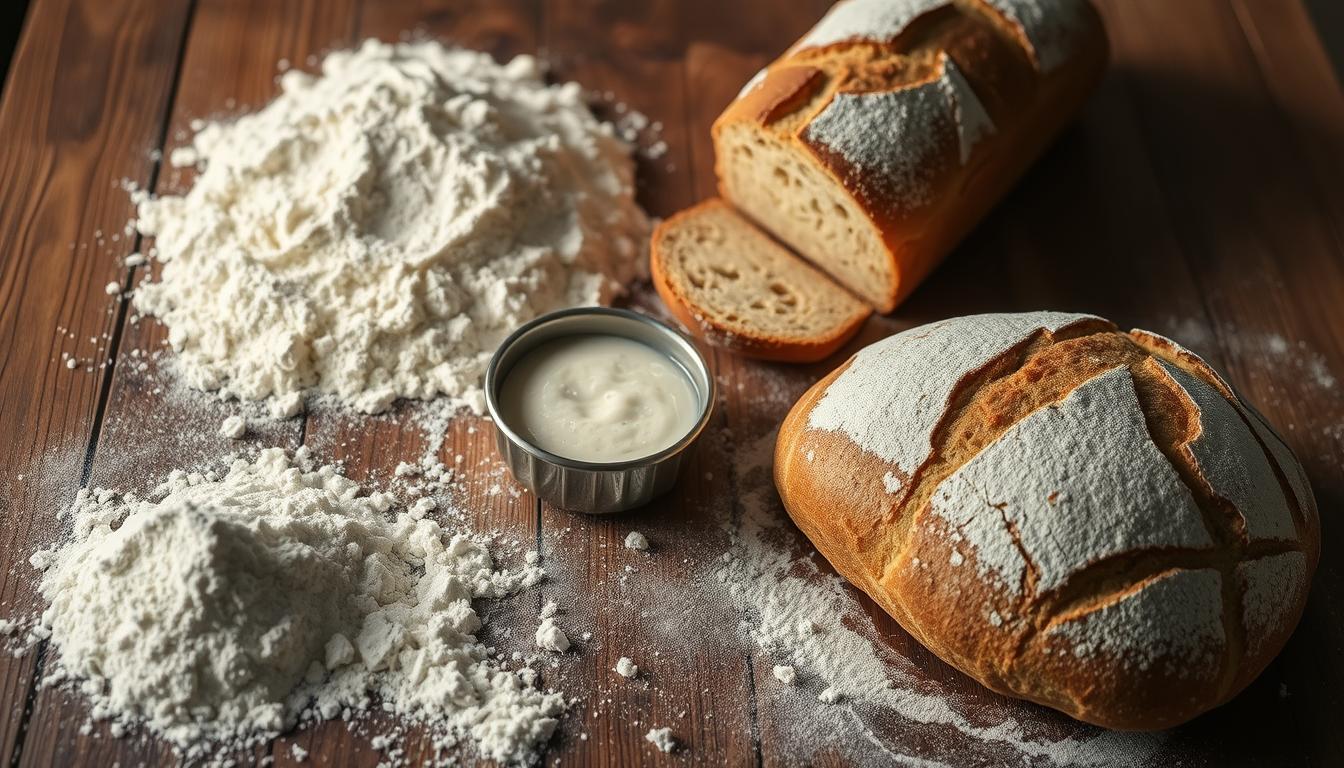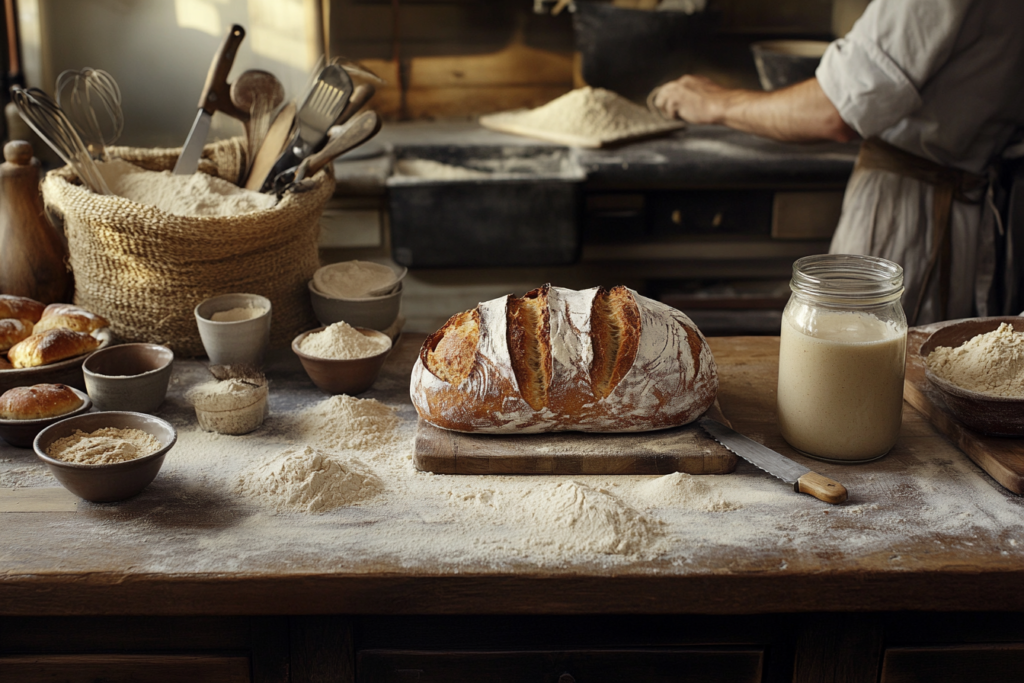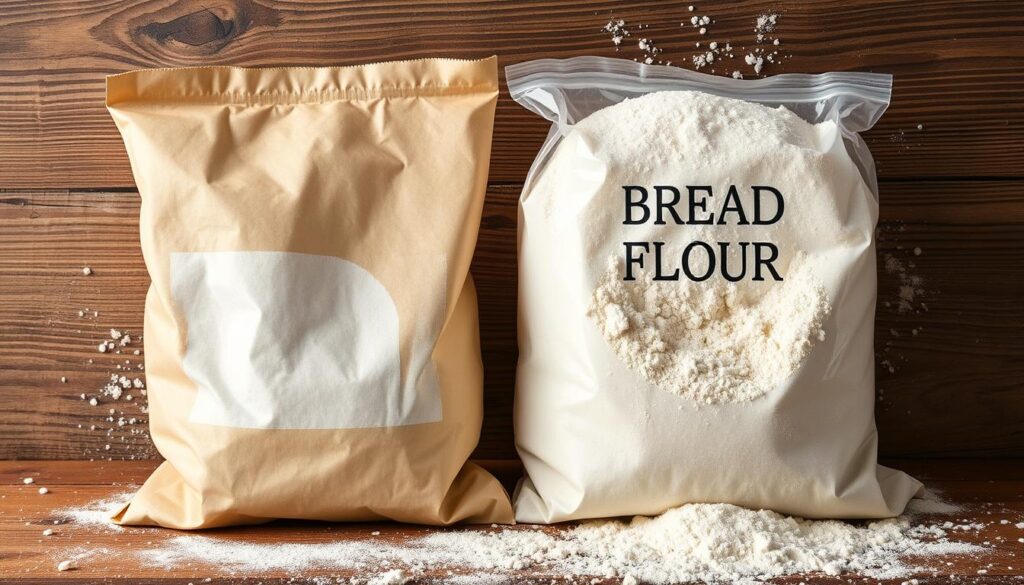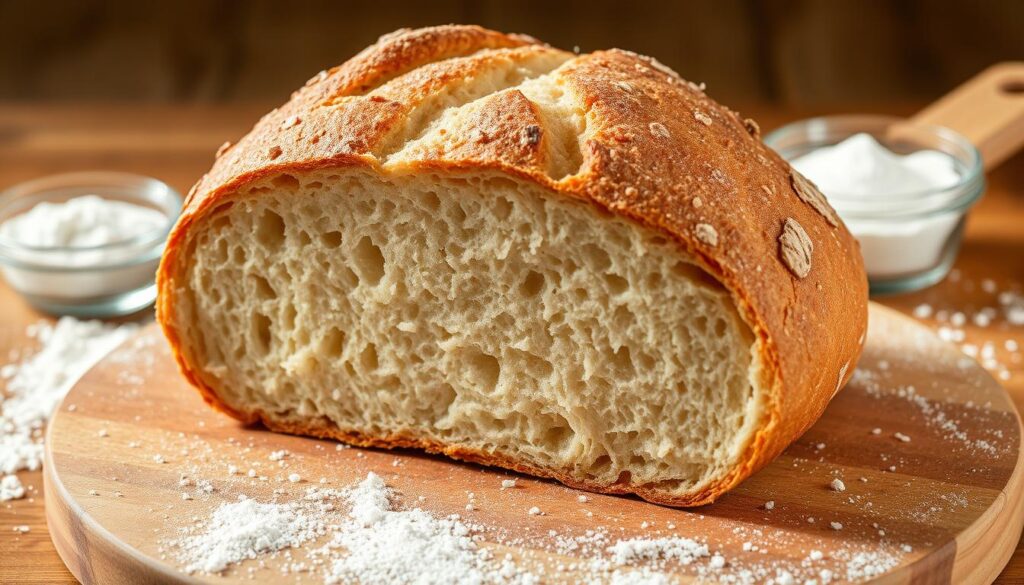Can I use AP flour for sourdough? Baking sourdough bread is incredibly rewarding. You get to watch the dough grow, enjoy the smell of fresh bread, and slice into a perfectly crusty loaf. It’s a craft that fills your heart with joy.
If you’re curious about using all-purpose (AP) flour for sourdough, you’re in good company. This guide will help you understand the use of AP flour in sourdough, making your baking fun and successful.
As a home baker, you might wonder if all-purpose flour can give you the same results as bread flour. Let’s explore the possibilities and limits of using AP flour in your sourdough recipes together.
Key Takeaways
- AP flour can be used in sourdough baking with some adjustments.
- Understanding the properties of AP flour helps in crafting better sourdough bread.
- AP flour’s protein content is lower than bread flour, impacting texture and rise.
- Hydration levels may need to adjust when using AP flour in sourdough.
- Experimenting with AP flour can lead to delightful and unique bread outcomes.
Understanding All-Purpose Flour in Baking
All-purpose flour, or AP flour, is a key ingredient in many baked goods. It’s the most common flour in homes, loved for its versatility. Knowing its definition and nutritional value helps us understand its role in baking.
What is All-Purpose Flour?
All-purpose flour is a mix of hard and soft wheat. It’s great for baking many things, like cookies, cakes, and bread. Its gluten content is just right, between 8-11%, which helps baked goods stay light and fluffy.
Nutritional Composition of AP Flour
| Nutrient | Amount |
|---|---|
| Calories | 455 |
| Protein | 13g |
| Carbohydrates | 95g |
| Fat | 1.2g |
| Dietary Fiber | 3.4g |
| Iron | 4.5mg |
| Calcium | 18mg |
This shows AP flour’s balanced nutrients. It has enough protein for structure but doesn’t overpower the texture. It also has important minerals like iron and calcium, which are good for health.
The Role of Flour in Sourdough Bread
Flour is key to making sourdough bread. The type of flour you use affects how the bread turns out. It changes the texture, flavor, and how it ferments.
Importance of Flour Types
Flour types have different roles in sourdough. High-protein flours like bread flour make the bread chewy. Whole wheat flour makes it denser and more robust.
All-purpose flour is versatile but might need more water. It finds a good balance but needs some tweaking.
How Flour Affects Fermentation and Flavor
The type of flour affects sourdough’s fermentation and taste. The flour’s protein and minerals work with the starter’s yeast and bacteria. This affects how the bread rises and its sourness.
Whole grains, with more nutrients, make the flavor more complex and strong.
Choosing the right flour can change your baking. It affects the fermentation and the bread’s taste. Using different flours makes each loaf special and tasty.
Can You Use AP Flour for Sourdough?
In sourdough baking, flour choice greatly affects the bread’s taste and texture. Let’s explore the good and bad of using AP flour for sourdough.
Pros of Using AP Flour
Many bakers choose AP flour for sourdough because it’s easy to find and versatile. It’s common in most homes, perfect for beginners. It also has a balanced protein level, leading to a soft crumb and good rise.
- Widespread Availability: Easy to find in supermarkets.
- Versatility: Suitable for a multitude of recipes beyond sourdough.
- Balanced Protein Content: Provides sufficient gluten for a good rise without being too dense.
Cons of Using AP Flour
However, baking with all-purpose flour comes with its own set of challenges. The protein content can vary, affecting the bread’s texture and structure. Also, AP flour might not give the same rich flavor or chewy crust as other flours.
- Inconsistent Protein Content: Can lead to variability in dough performance and bread texture.
- Limited Flavor: May not match the taste complexity of bread flour or whole grain flours.
- Structural Differences: Some bakers note a less chewy crust and slightly different crumb structure.
Knowing these pros and cons will help you decide if AP flour is right for your sourdough recipes.
Comparing All-Purpose Flour to Bread Flour
When you start baking sourdough, picking the right flour is key. Knowing the difference between bread flour vs. all-purpose flour can change your bread’s texture and feel.
Texture and Structure Differences
The flour you choose affects the bread texture. All-purpose flour, with less gluten content, makes bread softer. It’s great for delicate treats. On the other hand, bread flour’s high gluten content makes it perfect for chewy, robust sourdough bread.
Protein Content: AP vs. Bread Flour
Protein levels in flour are important for gluten development. Bread flour has 12-14% protein, ideal for a tall loaf. All-purpose flour, with 10-12% protein, is versatile but might not be the best for sourdough rise.
| Aspect | All-Purpose Flour | Bread Flour |
|---|---|---|
| Gluten Content | Lower | Higher |
| Bread Texture | Softer | Chewier |
| Protein Content | 10-12% | 12-14% |
In short, choosing between all-purpose flour and bread flour depends on your sourdough bread’s look and feel. Knowing these differences helps you make better choices and get the best baking results.
Tips for Using AP Flour in Sourdough Recipes
Making the perfect sourdough bread with All-Purpose (AP) flour needs special care. Here, you’ll learn how to adjust hydration levels and watch dough behavior for the best results.
Adjusting Hydration Levels
One key sourdough baking tip is to manage hydration levels in sourdough well. AP flour absorbs less water because it has less protein than bread flour. It’s important to get the water-to-flour ratio right for the dough’s consistency.
- Start with a hydration level of 60-65% and adjust to find the perfect balance.
- Use a digital scale for accurate measurements of water and flour.
- Watch how your dough behaves; if it’s too wet, add more flour. If it’s too dry, add more water.
Monitoring Dough Behavior
Working with AP flour also means watching how the dough behaves. The dough’s rise and texture are affected by its lower protein content. Paying close attention ensures your sourdough turns out right.
- Consistency: Aim for a dough that’s supple and elastic. But remember, AP flour dough is different from bread flour dough. Adjust as you knead and rest the dough.
- Fermentation: Watch the dough’s fermentation. AP flour dough might not rise as high but should still show signs of activity with air bubbles.
- Proofing: Proper proofing is key. Slightly longer proofing times can help achieve the right texture and crumb structure.
By following these steps, you can improve your sourdough baking. Understanding hydration levels in sourdough and watching AP flour dough consistency are crucial for success.
Sourdough Starter and AP Flour
Keeping your sourdough starter healthy is key for great baking. Using all-purpose (AP) flour to feed it is common. But, it’s important to know how it affects your starter.
Feeding Your Starter with AP Flour
AP flour is a favorite among bakers because it’s easy to find and versatile. It gives your starter the nutrients it needs to grow. The flour’s moderate protein helps with steady fermentation, not too fast.
Feeding your starter regularly is crucial. It keeps your starter healthy and active.
Effects on Sourdough Starter Activity
The flour you use affects how active your starter is. AP flour leads to a moderate fermentation rate. This helps your starter become strong and lively over time.
Watching your starter’s bubbles and how it rises is important. It shows if your starter is healthy and active. Here’s a comparison of AP flour with other flours:
| Flour Type | Fermentation Activity | Protein Content |
|---|---|---|
| All-Purpose Flour | Moderate | 10-12% |
| Bread Flour | High | 12-14% |
| Whole Wheat Flour | Moderate to High | 13-14% |
In summary, using AP flour for feeding is simple and effective. It keeps your starter active and healthy. Just watch your starter to make sure it’s ready for baking.
Creating a Basic Sourdough Recipe with AP Flour
Making sourdough bread with AP flour is easy and fun. This recipe is great for beginners. It offers a clear guide to baking perfect sourdough every time.
Simple Ingredients List
To begin baking sourdough with AP flour, you’ll need:
- 100 grams of active sourdough starter
- 500 grams of all-purpose flour
- 350 grams of water
- 10 grams of salt
Step-by-Step Instructions
- Mix the starter, flour, and water: In a big bowl, mix the sourdough starter, flour, and water. Stir until it’s a shaggy dough.
- Autolyse: Let the dough rest for about 30 minutes. This lets the flour soak up the water fully.
- Add salt: Sprinkle salt over the dough and mix it in well with your hands.
- First rise (bulk fermentation): Cover the bowl with a damp cloth. Let it rise at room temperature for 4-6 hours. Do stretch and folds every 30 minutes for the first 2 hours.
- Shape the dough: When the dough has doubled, turn it out onto a floured surface. Shape it into a round or oblong loaf.
- Final rise: Put the shaped dough in a floured proofing basket. Cover it and let it rise for 2-3 hours or overnight in the fridge.
- Preheat the oven: Heat your oven to 475°F (245°C) with a Dutch oven inside.
- Bake the sourdough: Carefully put the dough in the hot Dutch oven. Score the top, cover, and bake for 20 minutes. Then, remove the lid and bake for another 25-30 minutes until it’s golden.
- Cool the bread: Let the sourdough cool on a wire rack before slicing.
This guide shows how fun making sourdough bread with AP flour can be. With practice, you’ll get better at it. Soon, you’ll be making delicious sourdough that will impress everyone.
Enhancing Your Sourdough with AP Flour
Adding all-purpose flour to your sourdough can make it truly special. A few extra ingredients or whole grains can take your bread to the next level. This can turn a good loaf into an amazing one.
Adding Flavor with Other Ingredients
To make your sourdough even tastier, try adding herbs, spices, or cheese. Garlic, rosemary, or sun-dried tomatoes can add a wonderful twist. Spices like cinnamon or cardamom can also bring unique flavors that match the sourdough’s tang.
Experimenting with Whole Grains
Using whole grains in your sourdough can add texture and nutrition. Mixing in whole wheat, rye, or seeds and oats can make the dough richer. This adds a nutty flavor and boosts the sourdough taste. Here’s a quick look at some whole grain options:
| Whole Grain | Flavor Profile | Nutritional Benefits |
|---|---|---|
| Whole Wheat | Nutty, earthy | High in fiber, vitamins, and minerals |
| Rye | Rich, tangy | Rich in fiber, improves digestion |
| Oats | Subtle, slightly sweet | High in protein, good source of manganese and phosphorus |
| Seeds | Varies (sesame, sunflower) | Packed with essential fats, protein, and antioxidants |
Adding these whole grains can make your sourdough even better. It also increases the health benefits of your bread. The secret to better sourdough flavor is to experiment and enjoy the results.
Troubleshooting Common Issues
Working with sourdough can sometimes present challenges, particularly when striving for a perfect loaf. This section addresses key concerns like dense bread and inconsistent rise. It provides vital tips for effective sourdough baking troubleshooting.
Dense Bread: What Went Wrong?
One of the most common issues in sourdough baking is ending up with dense loaves. Various factors could be at play here, from flour quality to fermentation techniques. Make sure you’re using quality All-Purpose flour and maintaining appropriate hydration levels. Fermentation is also critical; inadequate fermentation can lead to dense, heavy bread.
- Insufficient Fermentation: Allow your dough to ferment longer to develop necessary air pockets.
- Improper Hydration: Adjust the water-to-flour ratio to create a softer dough.
- Weak Starter: Ensure your sourdough starter is active and bubbly before mixing.
Inconsistent Rise: Causes and Solutions
Achieving a consistent sourdough rise can be another hurdle. Several factors can affect this, including temperature control and dough handling techniques. Identifying the root cause can help you make targeted adjustments.
- Temperature Variances: Maintain a stable, warm environment for your dough to rise properly.
- Dough Handling: Handle the dough gently to preserve the gas bubbles formed during fermentation.
- Starter Health: Use a well-fed, vigorous starter to ensure robust dough expansion.
For preventing dense sourdough and ensuring every loaf achieves a consistent rise, consider keeping a baking journal. This will help identify patterns and improve your baking process over time.
| Common Problem | Possible Cause | Solution |
|---|---|---|
| Dense Bread | Insufficient Fermentation | Increase fermentation time |
| Dense Bread | Improper Hydration | Adjust water-to-flour ratio |
| Inconsistent Rise | Temperature Variances | Keep dough in warm, stable environment |
| Inconsistent Rise | Weak Starter | Feed starter more frequently |
Alternatives to All-Purpose Flour
Exploring flour substitutions in sourdough baking reveals whole wheat and rye flours as top choices. These flours add unique textures, flavors, and nutrients to your sourdough. They make your bread more diverse and robust.
Whole Wheat Flour
Whole wheat flour is great for boosting your sourdough’s nutrition. It keeps the bran and germ, adding fiber, vitamins, and minerals. This flour makes your sourdough denser and richer in taste than all-purpose flour.
When baking with whole wheat, you might need to adjust the water. Whole wheat flour soaks up more water than other flours.
Rye Flour
Rye flour brings a special flavor to your sourdough. It has an earthy, tangy taste and a denser, darker crumb. Rye has less gluten than wheat, making it more compact.
Adding rye flour can also improve fermentation. It holds moisture longer, making your loaf more moist and flavorful.
Trying whole wheat and rye flours in your sourdough expands your baking skills. You’ll enjoy a wider range of flavors and textures in your bread.
Frequently Asked Questions About Sourdough
Baking sourdough bread can raise many questions, especially with all-purpose (AP) flour. We’ve got answers to some common questions to help you get better at sourdough baking.
Can I Mix Different Flour Types?
Yes, mixing flours for sourdough is a great idea! Mixing different flours can make your bread taste better, feel different, and be more nutritious. For instance, adding whole wheat or rye flour to AP flour can make the crust better and the flavor more complex.
Here is a table outlining some recommended flour mixes and their potential effects:
| Flour Combination | Potential Benefits | Flavor Profile |
|---|---|---|
| AP Flour + Whole Wheat | Improves fiber content, adds nutty flavor | Rich, slightly sweet |
| AP Flour + Rye Flour | Enhances depth, boosts starter activity | Earthy with tangy undertones |
| AP Flour + Bread Flour | Better gluten development, chewy texture | Classic sourdough taste |
How Does AP Flour Impact the Taste?
AP flour’s impact on sourdough’s taste is a common question. AP flour has a mild, neutral taste that lets the sourdough’s tanginess stand out. But, some people think bread made only with AP flour might not have enough depth or flavor.
Knowing how AP flour affects taste can help you choose whether to use it alone or mix it with other flours. While AP flour is easy to find and use, adding other flours can make your bread more interesting and tasty.
Conclusion: Embracing AP Flour for Sourdough
Starting your sourdough journey with AP flour can be exciting. It’s a great choice for beginners and experts alike. AP flour’s flexibility and ease of use make it perfect for sourdough.
Understanding how AP flour works with your starter and dough is key. This knowledge helps you make the best sourdough recipes.
Final Tips for Success
Keep an eye on your dough and adjust the water as needed. These tips can help you get the right texture and taste in your bread. Try mixing different flours to improve your sourdough.
Adding whole grains or other ingredients can also add depth to your bread. Don’t be afraid to experiment.
Encouragement to Experiment with Baking
Baking sourdough with AP flour is a fun way to learn. It’s a chance to try new things and improve your skills. So, get your ingredients ready and start baking!
FAQ
Can I use all-purpose flour for sourdough?
Yes, you can use all-purpose flour for sourdough. It’s not the first choice because bread flour has more protein. But, all-purpose flour can still make a great sourdough loaf if you tweak the recipe a bit.
How does all-purpose flour affect the fermentation process in sourdough baking?
All-purpose flour has less protein and gluten than bread flour. This might make the dough less elastic. But, by adjusting how wet the dough is and how long it ferments, you can still get a good sourdough.
What are the pros of using all-purpose flour for sourdough?
Using all-purpose flour is easy because it’s everywhere and cheap. It’s also versatile, making it a go-to for many bakers at home.
What are the cons of using all-purpose flour for sourdough?
The downsides include the unpredictable protein content. This can mess with the dough’s structure and how it rises. All-purpose flour might make your loaf denser than bread flour would.
How does all-purpose flour compare to bread flour in sourdough baking?
Bread flour has more protein, which means more gluten. This makes the dough chewier and helps it rise better. All-purpose flour needs more water and longer fermentation to get similar results.
Can I mix different types of flour when baking sourdough?
Yes, mixing flours is a great idea. Using all-purpose flour with whole wheat or rye can make the bread taste more complex. It also boosts the bread’s nutritional value.
How does all-purpose flour impact the taste of sourdough bread?
All-purpose flour makes sourdough bread milder and softer. The taste is still tangy but might not be as deep as with higher-protein flours or whole grain mixes.




